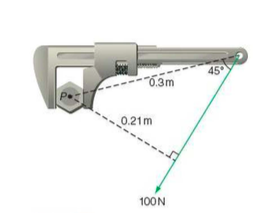Turning Moments
Introducing Moments
⇒ You know that it is easier to open something if you apply a large force far from the central point (or pivot) of rotation - and it is this which our notes on turning moments is all about
⇒ The size of the turning effect is called a turning moment or torque
⇒ Turning moment = force x perpendicular distance from the pivot
⇒ As Newton's first law of motion states, an object will remain at rest if the forces are balanced
- In other words, when the vector sum of the forces add to zero, a body will remain at rest or move at a constant velocity

⇒ Here we have two kids on a see-saw, which has a weight of 200N and is in equilibrium
⇒ The anticlockwise turning moment of the boy = 450N x 1m = 450Nm
⇒ The clockwise turning moment of the girl = 300N x 1.5m = 450Nm
- Since the clockwise and anticlockwise moments balance, one condition of equilibrium is met
⇒ The total weight of the see-saw and the children is 950N. The support provides an upwards force of 950N. So the resultant force acting on it is zero and the see-saw is in equilibrium
Centre of Mass

⇒ This shows a rod in equilibrium on top of a pivot
⇒ Gravity acts equally on both sides of the rod, so the clockwise and anticlockwise turning moments balance

⇒ This rod is the same as the other rod, except all of its mass is concentrated into the midpoint - this is known as the centre of mass
- The weight acts down through the pivot, so the turning effect is zero
⇒ The centre of mass is the point in a body around which the resultant torque due to the force of gravity is zero
- This is why you can always balance a body by supporting it under its centre of mass
Moments in Action
⇒ In real life, dealing with moments is often more complicated than what was mentioned above

⇒ This shows the action of a force to turn a spanner, but the line of action is at 45 degrees to the spanner, which makes it a little more complicated to work out the turning moment...
- There are two ways to determine the turning moment here
⇒ First, a scale drawing can be used that shows that the perpendicular force between the line of force and the pivot is 0.21m, so the turning moment is 100N x 0.21m = 21 N m
⇒ Second, the turning moment can be calculated using trigonometry because we can work out the perpendicular distance between the line of force an the pivot by multiplying the length of the spanner (0.3m) by sinθ (sin45)
- As moment is force x perpendicular distance, we can do the following sum: Force x (Length x sinθ)
- 100N x 0.3m x sin45
- 21 N m
Couples

⇒ Here a force is applied to an object, which will have two effects
⇒ The first is to set the object moving in the direction of the force (translation) and the second is to start the object rotating about its centre of gravity
- Because of this, if your attention was to only rotate the object, this one force that is applied is inefficient because the object moves in the direction of the force too...
- To avoid this problem, two forces are often applied to an object in parallel but opposite directions - this is known as coupling

⇒ You apply a couple when turning a steering wheel - the two forces turn the wheel but exert no translational force
Extra
⇒ Also see our notes on: